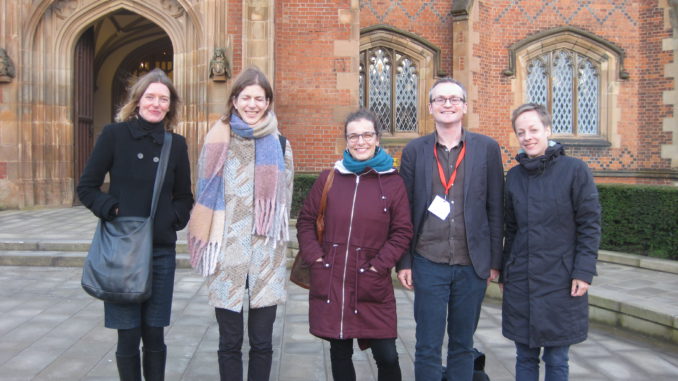
Post by Iva Peša, Research Associate in Environmental History, ‘Comparing the Copperbelt’ project, University of Oxford.
From 4-7 April 2018 the European Social Science History Conference was held in Belfast. This is a major conference that brings together ‘scholars who explain historical phenomena using the methods of the social sciences’ (https://esshc.socialhistory.org/). It is rare to find scholars of medieval history and contemporary labour historians side by side and to see that there is indeed a possibility for discussion between widely divergent historical sub-disciplines. The large number of participants enabled a broad temporal, topical and geographical scope, which provided inspiration for our own ‘Comparing the Copperbelt’ research project.
The conference featured a number of panels on topics related to African history, labour history, religious change, ethnicity and political mobilisation. Refreshingly, there were also excellent panels on methodology, transnational and global history, oral history and life history. It was a good forum to meet fellow researchers and to discuss our different topics, approaches and research questions.
Miles Larmer and Iva Peša organised a panel session on ‘Urbanism in Central Africa: (Extra)ordinary ways of understanding Zambian and Congolese cities in the 20th century’. This panel sought to engage in debates about the nature of urbanism from a Central African Copperbelt perspective. The four papers, two of which presented ongoing research from the ‘Comparing the Copperbelt’ project, dealt with the (extra)ordinary in order to problematise what it means to be urban in this region. How do issues of spirituality, architecture or urban agriculture fit into or challenge established conceptualisations of urban life in Zambia and Congo?
Kristien Geenen of the Workinmining project (www.workinmining.ulg.ac.be) at the University of Liège gave a fascinating account of ‘Kolwezi, the city of “copper eaters”: Urban planning determined by mining activities’. Through a detailed case study of Kolwezi from an urban planning perspective, she analysed the relationship between mining and the city. Kolwezi’s location, right on top of rich mineral deposits, led to its founding in the 1930s, but might equally bring about its demise. Workers’ housing is situated on cobalt resources and residents have started digging in their back yards to access these – literally undermining their own foundations. Geenen explained how this situation came about, paying attention to state, local authority and mining interests. Despite recurrent plans to relocate parts of, or even the entire city, Kolwezi has so far endured, as have the precarious residents. This is a great study of what it means to live with mineral deposits and how mining unexpectedly shapes urban life.
Rita Kesselring’s (University of Basel) paper was ‘An ordinary player in town: The local state in a new mining area, Northwestern Province of Zambia’. Further elaborating issues of urban planning, Kesselring gave a detailed ethnographic account of the city council in Solwezi – an area of both historical and contemporary extractive activity – and its relationship with mining companies. What do the council’s everyday activities reveal about issues of stateness and urbanism? As a key player in town, albeit with far fewer resources than globally linked mine companies, the city council tries to deal with the exponential informal growth of the city and its chaotic urban form on a daily basis. The (re)establishment of mining interests in Solwezi since 2000 has radically impacted on the city council’s ability to manage urban life, Kesselring convincingly argues. This paper analysed the influence of heightened revenue flows due to mining presence, but equally stressed how this has caused diminished authority and accountability of the council. Through case studies such as the construction of a road (see: https://www.sciencedirect.com/science/article/pii/S2214790X1730165X), Kesselring’s work shows how mining presence influences urban form and local authority.
Stephanie Lämmert (formerly of the ‘Comparing the Copperbelt’ project, now at the Max Planck Institute for Human Development Berlin) presented on ‘Spiritual identities in the Central African copper towns, c. 1950-1990’. She demonstrated the unease of early missionaries faced with the cosmopolitan life of the urban Copperbelt. Catholic and Protestant missionaries had to deal with the perils of modernity and materialism when preaching to urban Copperbelt residents, projecting their largely fixed notions of ‘modernity’ and ‘morality’. Yet Lämmert reveals how Copperbelt residents themselves negotiated spirituality through exploiting the fluidity of denominational boundaries. By surfing between different churches urbanites constructed their own forms of spirituality, quite different from those that missionaries projected and expected. By looking at Mindolo Ecumenical Foundation, the publication ‘Speak Out!’ and movements such as BaBuomba, Lämmert shows that urban spirituality was complex, profound and distinctly shaped by urban Copperbelt residents themselves.
Iva Peša (University of Oxford) delivered a paper titled ‘Farming on the Copperbelt: Urban agriculture and Central African urbanism’. Whereas Zambian historiography has portrayed agriculture as a rural phenomenon, agriculture was in fact central to urban life from the foundation of Copperbelt towns until today. This presentation analysed urban agriculture not – as is often argued – as a failure of urbanisation or a response to food crisis, but rather as an activity that enabled its mostly female practitioners to stake claims to the urban. How did mineworkers’ wives or informal urban residents envisage the growing of food in urban spaces? Mining companies and local authorities often vehemently denounced agricultural production, exactly because cultivating a plot of land entailed ‘rights to the city’. Peša revisited the place of agriculture in the urban setting, thereby considering the interaction between policy and practice in shaping the urban.
In the discussion, Miles Larmer (University of Oxford) reconnected the four papers to debates about the meaning of ‘the urban’ on the Copperbelt. All four papers successfully decentred mineral determinism and challenged binaries such as rural vs. urban and tradition vs. modernity that have been central both to social science research on urban Africa but also to popular understandings of town life. Most importantly, all papers highlighted the considerable variations in the ‘normality’ of urban Copperbelt life.
